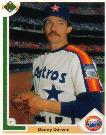
By Keith Glab
Whereas Bill James used primarily intuition to create his Runs Created formula, Pete Palmer took the average value of every offensive baseball event in instituting a Linear Weights value. He figured these values by using a computer simulation that modeled run production. The simulation corresponded to the results that George Lindsay got from recording 373 games of play-by-play data from the 1959 and 1960 seasons.
Basically, you take any event (say, a home run) and a situation (runner on first, one out) and subtract the initial Inning Run Expectancy from the Inning Run Expectancy after the event (in this case, 2.243-.498 = 1.745 runs). You then repeat the process for every situation, and every event, and come up with this easy additive formula:
.47*1B + .78*2B +
1.09*3B + 1.4*HR + .33*(BB+HB) - .27*(AB-H)
You can also view it as .47 for a hit +.31 for each extra base. A hitter with a negative value is hurting his team while one with a positive value is helping his team by that number of runs.
What Batting Runs does, is take a player’s linear weights value and adjust it for home ballpark and era. A value of zero is league average; a negative number indicates how many runs below average a player is, while a positive number counts a player’s run contribution over the average player’s.
Offensive Runs
.3*SB -.52*CS - .02K
Offensive Runs take strikeouts, stolen bases, and caught stealings into account. I’m assuming that whevever someone calculated the value of a strikeout that they have league averages for how often ground balls and fly balls advance runners, and how often hitters reach on a dropped third strike. Bill James uses the value .03 for his RC formula… I’ve also seen values below .02. I’m erring towards the lesser deviation from regular outs.
For SB and CS, Palmer came up with initial values and then bumped them up due to their situational nature (managers are more likely to steal in key situations where advancing a runner would be of more benefit, and scoring one run as opposed to bunches would be more appropriate). In doing so, he sneakily adjusted the ratio of SB and CS values to overly penalize hitters for a bad SB%.
One of the biggest Sabrmetric cons out there is the notion that you need a 75% success rate stealing bases to help your team. These are the actual era break-even values for SB% that Palmer’s model came up with:
1901-1920: ~62.5%
1921-1940: ~64%
1941-1960: ~65.5%
1961-1977: ~63%
That averages to about 63.5% from 1900-1977. In this offensive era of ours, the percentage is probably right around 66.6% -- 2/3 rather than the ¾ that stolen base naysayers would have you believe.
OR/162
OR*1.05
This adjustment simply treats pre-1961 players as though they had the opportunity to play in 162 games per season rather than 154. I increase their OR by 5%. If their careers overlapped the rule change, I adjusted that 5% by whatever % of the player’s career came before the rule change.
DPOR
-.26*(AB-H-GIDP)-.72*GIDP
or -.26*(AB-H)-.46*GIDP
Palmer never included double plays in his Linear Weights formulae, believing that they were more of a product of batting order than ability. I don’t see how anyone can look at the numbers and come to this conclusion. Yes, leadoff hitters are guaranteed one at bat where they cannot hit into a DP, but the differences between the #2-#9 spots in the order are negligible. And leadoff hitters get shafted in normal linear weights analysis anyway, since for them a BB and SB is just as good as a 2B in their first at bat (yet they’re credited with .15 fewer runs with the SB-BB combo). Therefore, I think that DPOR actually does a pretty good job of leveling the playing field.
I calculated this value of the DP myself using Lindsay’s data, but I’ve seen others calculate it (probably using more recent data) and come up with a similar number. FYI – the average player steps up to the plate in a GIDP situation once every five trips.
The Final Formula:
KLWTS= .47*1B +
.78*2B + 1.09*3B + 1.4*HR + .33*(BB+HB) + .3*SB
-.52*CS - .26*(AB-H-GIDP)-.72*GIDP
The Top 10:
|
Player |
BR |
OR |
OR/162 |
DPOR |
|
Babe Ruth |
1444 |
1386 |
1455 |
N/A |
|
Barry Bonds |
1248 |
1298 |
1298 |
1232 |
|
Ted Williams |
1067 |
1051 |
1104 |
961 |
|
Lou Gehrig |
1028 |
990 |
1040 |
N/A |
|
Ty Cobb |
1025 |
1030 |
1081 |
N/A |
|
Hank Aaron |
933 |
939 |
956 |
789 |
|
Stan Musial |
930 |
895 |
935 |
783 |
|
|
892 |
837 |
879 |
N/A |
|
Mickey Mantle |
884 |
876 |
900 |
824 |
|
Willie Mays |
859 |
876 |
896 |
761 |
Green – Statistics through
2004
Blue – Total CS totals are estimated from SB% of known seasons.
|
Become A Sponsor of BaseballEvolution.com Sponsor a page at BaseballEvolution.com. On a page of your choice, you can place a personalized message, a tribute to a player, or a link to your website! |
